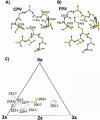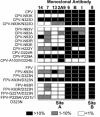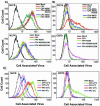Combinations of two capsid regions controlling canine host range determine canine transferrin receptor binding by canine and feline parvoviruses
- PMID: 12941920
- PMCID: PMC224579
- DOI: 10.1128/jvi.77.18.10099-10105.2003
Combinations of two capsid regions controlling canine host range determine canine transferrin receptor binding by canine and feline parvoviruses
Abstract
Feline panleukopenia virus (FPV) and its host range variant, canine parvovirus (CPV), can bind the feline transferrin receptor (TfR), while only CPV binds to the canine TfR. Introducing two CPV-specific changes into FPV (at VP2 residues 93 and 323) endowed that virus with the canine TfR binding property and allowed canine cell infection, although neither change alone altered either property. In CPV the reciprocal changes of VP2 residue 93 or 323 to the FPV sequences individually resulted in modest reductions in infectivity for canine cells. Changing both residues in CPV to the FPV amino acids blocked the canine cell infection, but that virus was still able to bind the canine TfR at low levels. This shows that both CPV-specific changes control canine TfR binding but that binding is not always sufficient to mediate infection.
Figures





References
-
- Agbandje, M., R. McKenna, M. G. Rossmann, M. L. Strassheim, and C. R. Parrish. 1993. Structure determination of feline panleukopenia virus empty particles. Proteins 16:155-171. - PubMed
-
- Agbandje-McKenna, M., A. L. Llamas-Saiz, F. Wang, P. Tattersall, and M. G. Rossmann. 1998. Functional implications of the structure of the murine parvovirus, minute virus of mice. Structure 6:1369-1381. - PubMed
-
- Ball-Goodrich, L. J., R. D. Moir, and P. Tattersall. 1991. Parvoviral target cell specificity: acquisition of fibrotropism by a mutant of the lymphotropic strain of minute virus of mice involves multiple amino acid substitutions within the capsid. Virology 184:175-186. - PubMed
Publication types
MeSH terms
Substances
Grants and funding
LinkOut - more resources
Full Text Sources
Other Literature Sources

